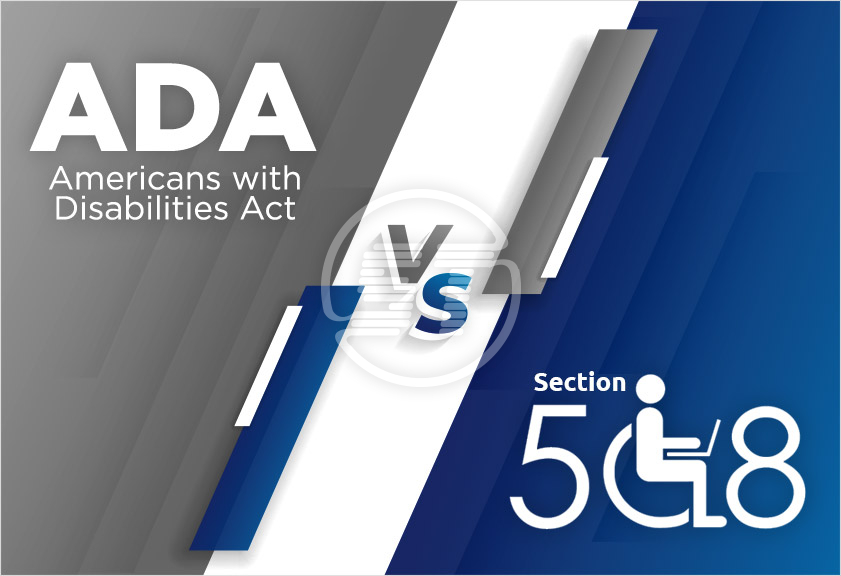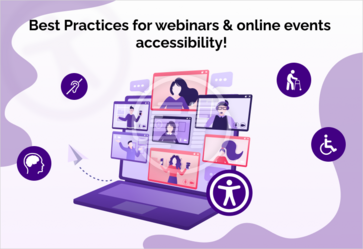The web is for everyone and all the information available on it is everyone’s basic right. Regardless of people’s locality, environment, and language, they are allowed to get all the information and knowledge. Rules and laws ought to make people’s lives easy. Likewise, there are two important standards that focus on the accessibility of all the information available on the world wide web. While these standards aim at accessibility, they are all distinct.
We keep on listening about ADA, section 508, WCAG, etc. These are the set of guidelines for different digital assets that make it convenient for people with disabilities.
If you are interested in improving the accessibility of your existing website or if you wish to create a new accessible website or application, ADA and section 508 compliance is a must for all the web assets.
In this article, we are giving you insights about what ADA and section 508 are and how they are different from each other.
What are ADA and Section 508?
ADA (Americans with disabilities act) is a civil rights law that restricts electronic media and information technology for discriminating against people who have some sort of physical disabilities.
Section 508 is a federal law that emphasizes federal agencies to use, develop and maintain such technologies that are easily accessible to people with disabilities. This law is a part of the Rehabilitation Act (1973). It brings people with disabilities like blindness, deafness, motor disabilities, and others under its gambit. And it is applicable to websites, web-based applications, emails, PDFs, software programs, devices, etc.
Both laws are compulsory in the US. Firms or agencies that do not adhere to ADA and Section 508 must face the consequences. They can be fined $55,000 to $150,000 for not complying with the ADA rules. In the case of section 508, a firm can also get entrapped informal complaints and lawsuits.
ADA vs Section 508 Compliance
The major difference between these two standards is how they prioritize the different facets of web operations and compliance to provide all the users with an accessible digital space.
ADA focuses on all the private, public sector, local government, state government, and commercial facilities to provide a complete accessible digital experience to every single user of digital products. ADA has a broad audience base. It was released by the department of justice in 1990 and revised in 2010 to make digital assets accessible for specially abled people. With WCAG compliance level guidelines for ADA, your business can earn more profits by reaching all web users.
ADA covers the following aspects of the website to be accessible:
- All live videos should have captions.
- Audio description for all the pre-recorded audios is a must.
- The text and image contrast ratio should be 4.5:1.
- Users should be able to resize the text up to 200%.
- There should be more than one navigation option for users. For example, HTML sitemap, site search, etc.
- Headings and labels to describe the content.
- A keyboard focus indicator is needed for users who are using keyboards to access the content.
- The page should have a language attribute to translate the content into all the languages.
- Suggestions must appear to correct the errors in the form of texts.
- A page with sensitive information, such as a payment transaction page, needs to have error prevention. There should be an order confirmation or cancel order option.
Section 508 gives preference to federal agencies, federal government departments or sectors. It says, all the federal agencies should provide accessible electronic and information technology instruments to everyone using or working on such instruments. When they develop, procure, and maintain any web product, they must follow the suggested guidelines.
The US Access Board has given rules for developing accessible information and communication technology (ICT). The board finalized the set of guidelines for Section 508 with the help of web content accessibility guidelines (WCAG 2.0) and the standards issued by the European Commission ICT.
According to Section 508
- Every software, websites, social media pages, blog posts, information kiosk, etc. must be accessible to all the federal agency’s users even if they have physical, cognitive or sensory impairments.
- Audio description should be there in every visual content to make it comprehensible to avoid any kind of discomfort for the person using the visual content.
- Content should have proper labels to make it accessible using assistive devices.
- Alphanumeric keyboard must work to navigate the content.
- Real-time text should be used for conversational purposes.
- Variable message signs ought to be included in the content with scrolling, streaming and paging down.
- Voice over internet protocol to provide real-time voice communication is compulsory in all web products. Etc.
- Web-based intranet and internet information and applications, operating systems.
- Telecommunications Products, Video and Multimedia Products, Self-contained, closed products, Desktop and portable computers.
Both ADA and Section 508 accommodate accessibility, yet their target segment is different. WCAG assists in creating a digital asset to be compliant with the suggested guidelines of both laws. It has a whole section (level AA) for ADA compliance (as mentioned above) and Section 508 can be achieved as well using WCAG 2.0.
Additionally, Explore the difference between ADA and Section 508 via this infographic:

Why do ADA and Section 508 matter?
There is a significant number of people across the globe with some sort of physical disability. These people cannot access all the digital products available if the products are not made as per prescribed guidelines. So, to provide an accessible digital experience to everyone, you need to create and maintain a digital product that complies with ADA or Section 508 or both.
How do you get an ADA and Section 508 compliant digital asset?
If you have an in-house web design and development team, then you can create a compliant website using ADA and Section 508 guidelines. Otherwise, hire an agency for ADA compliant website design and development to acquire a fully compliant website.
Depending on the size and complexity of your website, an agency will help you to create and run a successful website that adheres to all the web accessibility guidelines.
Wrapping-up
Creating a compliant website is sometimes overwhelming as your team have to go through all the quality checks for these guidelines again and again until all the guidelines get fulfilled. By making ADA and Section 508 compliant websites, you evade legal issues and run a successful website or a digital asset. If you already have an ADA and Section 508 compliant website, it requires regular ADA website audit its consistent performance.
Is your website, web app, documents, or mobile app accessible to people with disabilities? If your answer is No and you are looking to convert your business website or application into ADA or Section 508 compliance or looking for a new accessible website or application, our specialized and dedicated team provide complete ADA web accessibility services including audit, strategy, design, and development services that comply with accessibility regulations such as ADA, WCAG 2.0, 2.1, 2.2 and Section 508 within your budget. Get in touch with us at hello@skynettechnologies.com or submit the following request free quote form.


